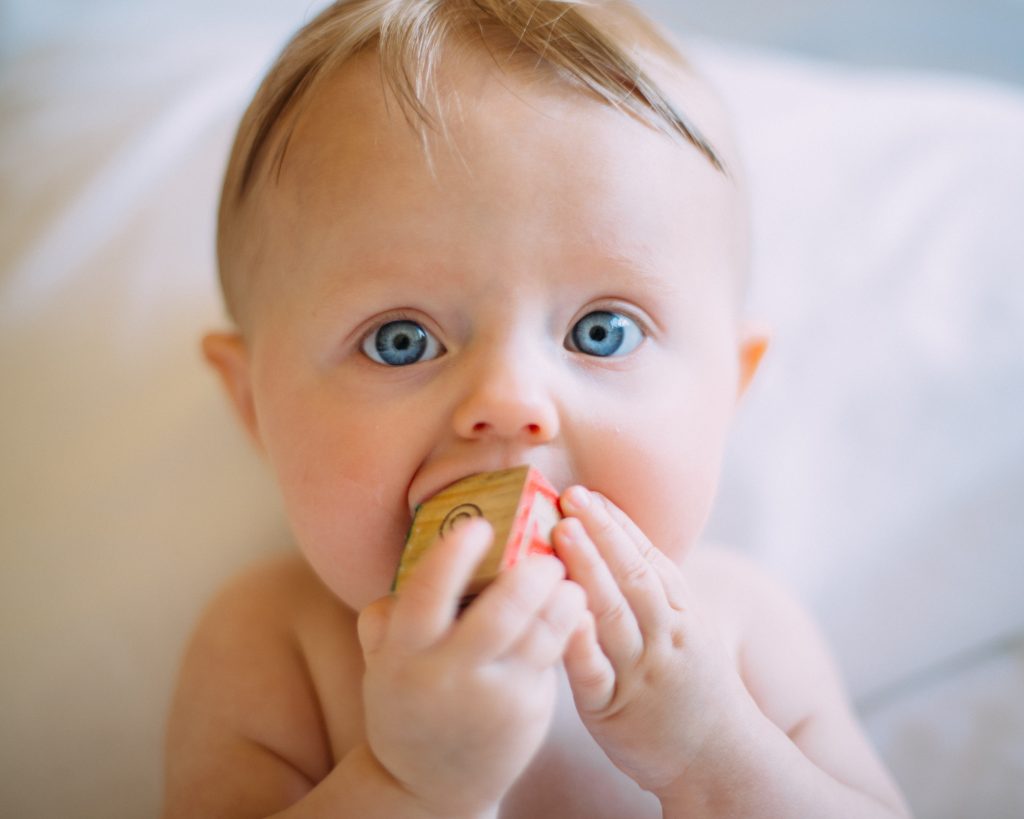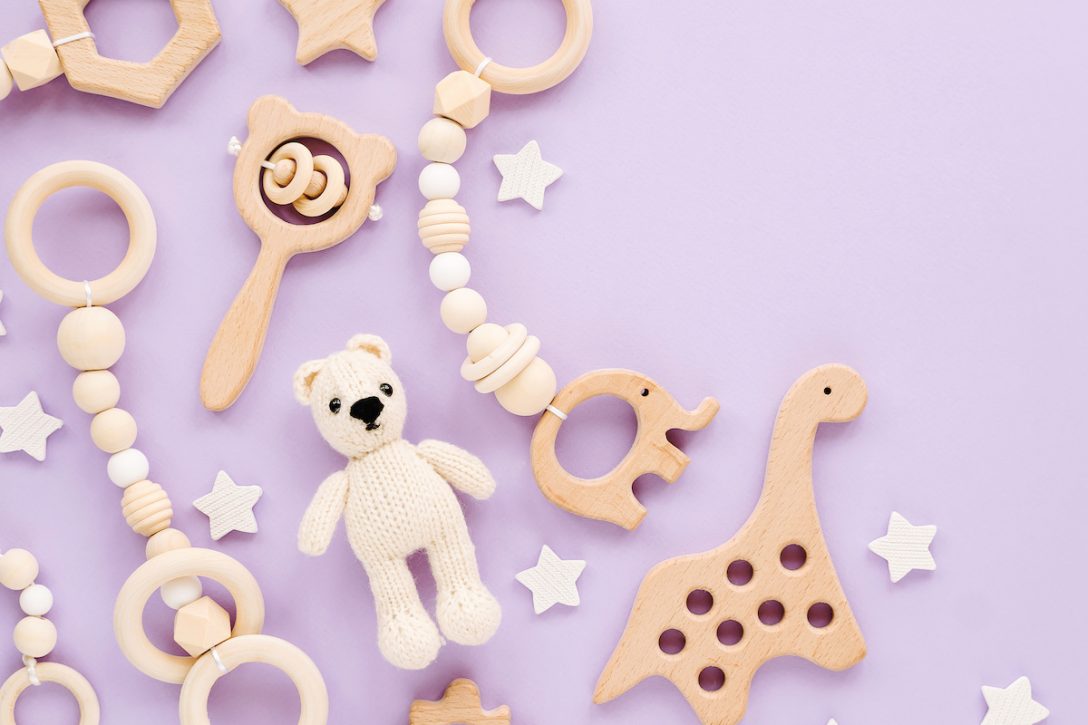And an extensive list of items for the treasure basket
Elinor Violet Goldschmied was an English educator and pioneer of treasure basket play. She believed that infants should learn by themselves, and should be given the opportunity to choose items and explore. With this in mind, in 1940 she came up with the idea of a treasure basket for babies. This concept became widely known and today most child care setting has some sort of treasure basket in their infant room.
She also promoted the concept of “Heuristic Play’ to provide the best opportunity for learning to toddlers.
What is a baby treasure basket?
According to Elinor,
Ideally the basket itself should be a round, low and rigid-sided wicker basket (with no handles) of about 30 cms in diameter and 12 cms in height, filled with between 80 and 100 different items, safe and small enough for a seated baby to handle, but varied in substance, texture, appearance and smell. Items can be made from leather, wood, fabric, rubber, metal and glass alongside the wondrous objects that can be found in the natural environment such as shells, pebbles and pine cones. It is best to avoid any objects made from plastic: they are not only dull in taste, smell and texture, but a baby’s world has enough plastic in it as it is.
Anita M. Hughes, Jacqui Cousins. 05 Jun 2017, Play birth to three from: The routledge international handbook of early childhood play Routledge. Accessed on: 17 Jan 2022
In short, a basket full of safe and natural items.
And no, my basket never had 80 or 100 items. I used what I could find in the house.
A treasure basket is also called a sensory basket or a loose play basket.
Why offer a treasure basket or sensory basket?

- To stimulate interest, curiosity and concentration
- To offer multi-level learning opportunities
- To encourage self-learning and independent play
- It offers a safe opportunity to explore objects from the real world.
- Because exploratory activities create new and vital neuronal connections in a baby’s developing brain and facilitate accelerated learning and intelligent thinking.
- It offers the first experience of selecting and decision making. The baby can choose what to play with and how.
In short, it’s worth spending time and energy on a treasure basket.
At what age baby can play with a treasure basket?
Start offering a treasure basket as soon as they sit up with support and show interest.
The Treasure Basket is a resource for the seated baby (5–10 months) and the open-ended materials for facilitating Heuristic Play provide the best opportunity for learning at this stage.
Anita M. Hughes, Jacqui Cousins. 05 Jun 2017, Play birth to three from: The routledge international handbook of early childhood play Routledge. Accessed on: 17 Jan 2022
As per experts, babies can concentrate on an object for a significant period but toddlers can’t. Toddlers between one and three years of age will just scatter all the items and move on. However, older children (above 3) will be able to independently play with a treasure basket.
But if you ask mothers on online forums, they would say that all kids play with treasure baskets. But toddlers have less attention span and older kids get bored. So babies can get the most out of it.
My daughter played with the same treasure basket up until the age of 10 or 11 months.
Later, I had to keep adding and removing objects from her treasure basket to make it interesting for her.
Around 16 months of age, she started showing more interest in heuristic play. So we moved on to toddler activities games. We are still using all the items from the treasure basket for heuristic play.
How to make a treasure basket?
Babies explore the world around them by examining things. They do this by looking, holding, shaking, banging or mouthing them.
Therefore, think about sight, touch, sound, smell and taste to provide a rich sensory and stimulating experience.
You don’t have to have 80 to 100 items in your treasure basket. start with what you have in the house and take it from there.
However, an important rule of Elinor’s treasure basket play is that you should watch the baby play but do not interfere. Sit with your baby to give a sense of security but interact only when the baby wants you to play or talk.
“The babies are in charge but we the adults have the responsibility to keep them safe and provide things to encourage their innate curiosity, appeal to their interest and curiosity, and enable them to develop and enjoy learning as they play.”
That is why it is important that you feel comfortable with all the items in the basket to avoid any negative interaction.
Also, you can create themed treasure baskets. For example, from the kitchen, from the garden, from the beach.
Or a collection of brushes, spoons, cups, containers, rings, woods, pebbles, balls, shiny items, noisy items etc.
For inspiration check out the list below.
An extensive list of items for a treasure basket
Balls
- Tennis Ball
- Airflow practice golf ball
- Spike ball with Led light
- Baby sensory balls
From your wardrobe
- Scarves, bandana and mufflers
- Hats
- Swimming cap
- Socks
- Hand gloves
- A variety of fabrics – cotton, polyester, terry towel, knitted, denim, silk etc. Use small items such as a handkerchief, face towel, ties, silk pocket inserts, knitted placemats etc.
- Empty Wallet ( double-check for coins)
From your kitchen
- Measuring spoon
- Muffin cases
- Nested cups or glasses (unbreakable)
- Whisker
- Spoons in various sizes and materials
- Pastry brush
- Vegetable cleaning brush
- Dish sponge (new, washed)
- Kitchen timer
- Banana carriers case
- Lemon or avocado saver
- Your plastic reusable coffee mug with a ball inside
- Nested plastic containers
- A set of strainers
- Salad spinner
- Coasters
- Honey dipper
- Egg cup
- Honey dipper
From refrigerator
- Whole Apple/ pear/ peeling clementine
- Whole and firm Tomato, potato, carrot
- Leaves kale, spinach, chard
- Lemon, lime, celery
- Herb packets
From your crafts collection
- Paper or Satin Ribbons
- Zipper
- Empty spool
- Small wool ball
- Large pom pom
- Large ball of wool or felt
- Cards
- Brush and paint tray
From your office
- Variety of Papers
- Old mouse
- Old keyboard
- Old phone
- Gel mouse pad
- Post-it notes
- Large keys
From your garden
- Bags of flower petals and herbs
- Sticks
- Pinecone
- A smooth piece of wood
From your vanity kit
- Brushes
- Empty container
- Comb
- Tooth-brush
- Water mist bottle
- Shower cap
- Loofa
- Face towel
- Large cotton ball
- Fabric hair crunchies
- Tissue paper
- Wet tissue in a container
Others
- Dolly pin
- Large baby medicine syringe
- Cool and hot packs
- Compression bandage ( without pin)
- Empty plastic bottle
- Large lids with soft corners
- Scoops
- Bathroom curtain rings
- Wooden rings
- Large wooden blocks from tower game
- Rubic’s cube
- Shoe police brush (clean)
- Large Seashells
- Pumice stone
- Candleholders
- DIY bottle shakers
What safety measures to consider
- Use your discretion to choose what is right for your baby and what is not.
- Never leave a baby unattended with a toy.
- Choose only safe and clean items because babies put things in their mouths.
- Think about choking risk. No small parts that they can put in their mouth.
- Select items with smooth edges and corners
- Babies can get their fingers stuck. Assess risk.
- Toddlers can wrap things around their necks. Such as rope, belts, chains, elastic exercise bands. Avoid or keep an eye on them.
- If your baby throws things when frustrated, upset or otherwise. Avoid heavy and large items that can hurt, such as large stones.
- Start with basics such as teethers, soft toys and balls. Gradually add more interesting items.
What can I use as a basket?
I have used the following
- A proper shallow and wide basket
- Fruit basket
- Small tub
- Refrigerator organiser basket
- laundry basket
- fabric cube
- Empty Shoebox
The best developmental toys for 6-12 months olds
Use your discretion when selecting items. For example, I wouldn’t give a leather wallet to my six months old. Because she may chew on it and some nasty leather particle may end up in her tummy.
However, I offered a wallet with some fake cards to my 16 months old and she loved pulling out colourful cards. That brings me to my next point.
Be creative. Observe what your kid enjoys doing and offer toys and activities accordingly.
That’s all I have for now. However, I will keep updating this post as and when I have something new to add. So do revisit this post.
When I was reading the paper mentioned above, Ms Hughe’s one statement made a lot of sense to me
“What I love about watching babies and young children playing is that they have no sense of failure, feeling perfectly competent and happy when their handling of objects or manipulating their bodies is clumsy or lacking in skill. Sadly it is through the socialisation from older children and adults that very young children learn that failure is something to be avoided and to feel ashamed about.”
Please feel free to share your ideas and thoughts in the comments.
With best wishes

